Circular design plays a central role on the way to a circular economy. In order to provide actors in the product development process with a powerful but simple tool for the design of circular products, the Institute of Design Research Vienna has developed the Circular Design Rules. Based on scientific design research, the result is a system intervention with a set of only 9 rules, changing the way the industrial ecosystem works.
There is a pressing need to change the way how we design products to achieve ambitious global environmental goals and reach circular economy in the upcoming decades. Circular Design (CD) is still not well integrated in design education and the day-to-day work of product designers and engineering departments. Designers and manufacturers are not speaking the same language when they talk about “sustainability” and “circularity”. Circular design is often misunderstood as ambition to improve end-of-life scenarios (recycling).
The Circular Design Rules give designers a powerful but simple tool to change the current linear design approach into a circular design innovation process. The toolkit has an attractive graphic and haptic design with gaming cards, an appellative and poetic language and use system theory to intervene into the industrial ecosystem in a transformative way. In less than 15 minutes, stakeholders from design processes can find out strength and weaknesses in terms of product circularity. The toolkit has a creative commons licence and is free of charge. This toolkit gives designers, engineers and product marketing a set of rules as well as a common language of what aspects are needed, shows milestones towards sustainability and serves as an innovation tool.
Please highlight how the project can be exemplary in this context
Sustainability is often claimed by designers and manufactures for new products. Looking behind the green arguments, they show up as greenwashing and incomplete design strategies towards CD. The “Circular Design Rules” (CDR) have been developed with the target to
- have only a small set of indicators for circularity in design
- address the complexity of sustainability with networked indicators
- provide strong indicators
- have clear milestones towards full circularity
- provide a common ground and language between designer and manufacturer
- have a simple and fast evaluation of the project at any stage
- include different system levels from small to big scale
- have a playful experience with CD
The toolkit is based on an analysis of existing CD Toolkits or guidelines used in the design and engineering field, including prominent toolkits like IDEO´s “Circular Design Guide” developed for the Ellen McArthur Foundation. The indicators (design patterns) found have been analysed with Frederic Vester´s impact analysis. Indicators have been identified which are strong influencers of circularity. Longevity, for example, one of the most cited sustainable design properties, is a very weak indicator as it is influenced by many other factors. It can be the result or the goal of circular design ambitions, but it is a very weak driver for CD. So, we dropped it in favour of other, stronger indicators. The toolkit is covering three different levels of CD:
- Product Systems
- Product Components
- Product Materials
Each of the three levels are broken down into further three CD indicators. On system level service systems, product return schemes and re-manufacturing are mandatory for system change. On product component level, modularity, upgrades and updates as well as separability are the driving factors of CD. On the product material level, the recycling input and output as well as the reduction of different material usage have been indicated as powerful CD indicators.
Please highlight how the project can be exemplary in this context
As the CDR toolkits target audience is mainly designers, the aesthetics is key in the adoption for everyday use. The 9 Circular Design Rules are printed as playing cards which are packed in a poster. The poster graphic is a reference to “Global Tools” – a group of Italian radical designers and architects (1973-1975). Our tool is the megaphone, which stands for standing up, shouting out loud and protest the slow adoption of CD principles in the discipline. With poetry, we want to make designers think different and find new solution by shouting out:
“Turn disposable products into heirlooms or build houses for just one generation!”
Ten years ago, IDRV has organized the exhibition “Tools for the Design Revolution” in the Vienna Design Forum, which has been followed by the book project (2014) with the same title. The graphic design has been done by grafisches büro and is based on the corporate design of “Global Tools”. We reached out to the veterans of the movement to get the permission to use the bolt visual language. We were inspired to continue the pioneering pedagogical design movement. Every rule can be shouted out with the megaphone:
“Design the take-back process of the product!”
“Design the product modularity!”
“Design the product with little material”
The “card game” is haptic and playful. A scorecard is helping to trace the achievements of the design process. Simple symbols help to keep track of achievements:
- A dot: first step done
- A half circle: on the way
- A full circle: circularity almost achieved
On every playing card, there are references to other cards which are substantial to achieve the CD goal: without designing the take back – how can we achieve remanufacturing? So, the cards can be also used as innovation tool.
Please highlight how the project can be exemplary in this context
National and international labels and certificates are proving circular design achievements. On European level the Ecolabel or on national level like Austria’s “Umweltzeichen” are setting targets for product categories. Certification schemes like “Cradle to Cradle” or the LCA (Life Cycle Assessment) are also in-depth evaluations with traceable indicators.
We think these labels and certification schemes are not inclusive in terms of cost and complexity. It is difficult for smaller businesses to finance the labels, but it is nearly impossible to finance an outsourced LCA or a “Cradle to Cradle” certification. So we felt the need to come up with a more inclusive “CD certification toolkit”
INCLUSIVE LANGUAGE:
Beside free access to the toolkit, we have achieved an inclusive approach by using simple language and avoiding expert speech and scientific terms without sacrificing precision and clarity. With our approach of visual and haptic experience, we hope to overcome barriers of design practitioners to use expert tools.
IDRV is a partner of the Learning Network of Sustainability (LeNS), an international network of design universities. Partner universities have helped to translate the toolkit in their teaching language. The CDR's are available now in the following languages:
- German
- English
- Spanish
- Portuguese
- Chinese
OPEN SOURCE/FREE COPIES:
The CDR Toolkit is published under a Creative Commons licence and can be freely downloaded as PDF:
Our dissemination partners (designaustria, Vienna Business Agency) are also providing hard copies of the toolkit (5500 printed) and disseminate them for free.
DIGITAL ACCESS:
There is a lot of positive feedback to the playing cards. But there is also the wish to translate the toolkit into a smartphone app – a wish manly coming from a young generation of designers. We hope to get funding for this soon to scale the impact of the toolkit.
Please highlight how this approach can be exemplary
The CDR's have been developed as a design research project with the aim to make designers changemakers in the transition towards circular economy. Beside scientific excellence and an innovative approach to reduce the number of indicators while keeping all necessary elements and connections of the complex system in place, we had to find the right “form” (Gestaltung) for the toolkit. IDRV has 10+ years of experience in knowledge transfer of design science by curating public talks, publications and exhibition design and curation. We are using graphic design as a tool to make science an easy to consume good and playful tool. We are using simple language and poetry to protest against the linear economy and shout out 9 rules to change the design world. IDRV was one of the first partners of the NEW EUROPEAN BAUHAUS project in Austria and we have always used inclusiveness, beauty and sustainability as our guiding principles.
To achieve system change in the industrial ecosystem, we have applied the “5R” analysis to understand system intervention strategies:
- Resources (System Input)
- Results (System Output)
- Relations (between Actors)
- Roles (of the actors)
- Rules (of the “game”)
A very effective system intervention is to change the “rules of the game”. This is exactly what the CDR's are aiming for. A rule change is an effective system intervention from the outside of the system which is transforming the Roles (e.g., designer as evangelist for CD), the relations between actors (cooperation on CD targets, sustainable supply chain) – targeting resources towards CD and finally resulting in product designs which are more compliant with Circular Design principles.
Please also explain the benefits that derived from their involvement.
Although the CDR's are an “expert tool” which is based on scientific research and expert interviews, citizen involvement is guaranteed through dissemination on “bewusstkaufen.at”. The website is run by the Austrian Ministry of Climate Action (our main supporter) and gives advice on eco-labels and climate friendly shopping in different categories from food to electronic products. The CDR's can help environmentally conscious consumers to ask critical questions like:
- Are there alternatives to buying - can I just pay for the usage?
- Can I update/upgrade, repair, maintain the physical product later?
- How much recycled material input is in the product?
- Can I buy the product refurbished/re-manufactured?
Also, for end consumers, the 9 evaluation cards are a creative tool to rethink their consumer patterns and take more informed consumption decisions and ask questions about a products' circularity. The environmentally friendly Austrian end consumer initiative runs also a lot of public events where the CDR toolkit will be promoted, and valuable feedback can be collected from citizens.
Circularity in product design depends on local solutions. We have incorporated several milestones in the evaluation process which are key to contribute to the global challenges. Energy transition to renewables is not explicitly addressed in our toolkit, but of course a precondition to reduce the CO2 emissions of products significantly. The Ellen McArthur Foundation has shown, that 55% of greenhouse gas emissions can be reduced by the energy transition. That means that there is still 45% of emissions which needs to be reduced by the design and alternative usage scenarios. The European Environmental Agency has identified that appr. 80% of a product's environmental footprint is decided in the design process. That shows the importance of introducing the CDR toolkit in the development processes. Examples of global contributions from our toolkit on a local level:
- Usage of locally available materials
- Local recycling facilities for end of life take back
- Local repair and refurbish centres
- A convenient, local take back service system from the manufacturer
- A repair manual which is easy to access
- Easy to disassemble products with less material complexity
Evaluation tools for circularity are complex and costly and time-consuming, and need most of the time additional external experts. The CDR toolkit has a very reduced set of indicators in comparison to existing tools, but they are all effective and address the different levels of product circularity. CDR might not make product labels obsolete or replace LCA or C2C assessment, but supports efforts to do so. Our target was that the assessment can be done by designers and engineers. Product management can set targets for product circularity in an informed way without falling into the greenwashing categories. The evaluation can be done in less than 15 minutes at every stage of the process, while other tools require more information input and time due to a wide range of assessable indicators.
Best practice example:
- A big stock market listed company in Austria has introduced already a proprietary version of the CDR's to guide the design and engineering process of all new developments and check circularity at all gate meetings. Although the company uses LCA and has started an external C2C evaluation process for a pilot project, the CDR's support the internal circular innovation process as engineers and designers need to find new and better solutions for the 9 indicators. The toolkit became a conversation piece which forces rethinking design decision of the past.
- A design studio which was part of our focus group is now using the toolkit to not only inform their design process, but also to use the CDR's to communicate with suppliers and manufacturers. The products they offer from their homepage use the arguments for circularity as selling points. The toolkit has empowered the design studio to use CD as the starting point for all of their products and the competitive positioning of their studio without spending resources on external consultants, labels or expansive LCA tools.
Please provide clear documentation, communication of methodology and principles in this context.
The “Circular Design Rules” have been tailor-made for “Product Design” in the first version. After intensive dissemination, we got the request to transfer the toolkit into new application fields:
- Food: The Vienna Business Agency has a program on food design innovation. We have been asked to translate the toolkit for the food ecosystem. In that case, we would invite a partner to extend the expertise into food systems. We would stay with the existing matrix. Only a few rules have to be adjusted, like the “upgrade” category.
- Architecture: Circularity has become a major topic in architecture. Part of the assessment can be products used in architecture such as windows. For them, the CDR apply without any changes. Also, windows would profit from a take back scheme as for example the alloy of aluminium or a specific plastic or glass can best be circulated with high value recycling from the manufacturer. For the bigger scale parts (concrete, steel beams, …) it needs a specific toolkit for assessment but also based on the three levels.
- Textile Industry: This industry counts also for a significant part of greenhouse gases. CDR's would need to address industry specific questions of circularity, but the matrix would be kept.
- Design Prizes: Almost every design prize is asking for a sustainable design. IDRV has rejected juries in the past because that category is often filled with greenwashing claims. Design prizes have been introduced in the 1950’s to raise awareness of design. Introducing the CDR as self-evaluation tool would help to base jury decisions on circular design facts and promote best practices
- NFT Circular Design Collection: using blockchain technology to track product self-evaluation. A decentralized, self-organized community (DAO) of producers, suppliers and designers making their efforts in circular design transparent.
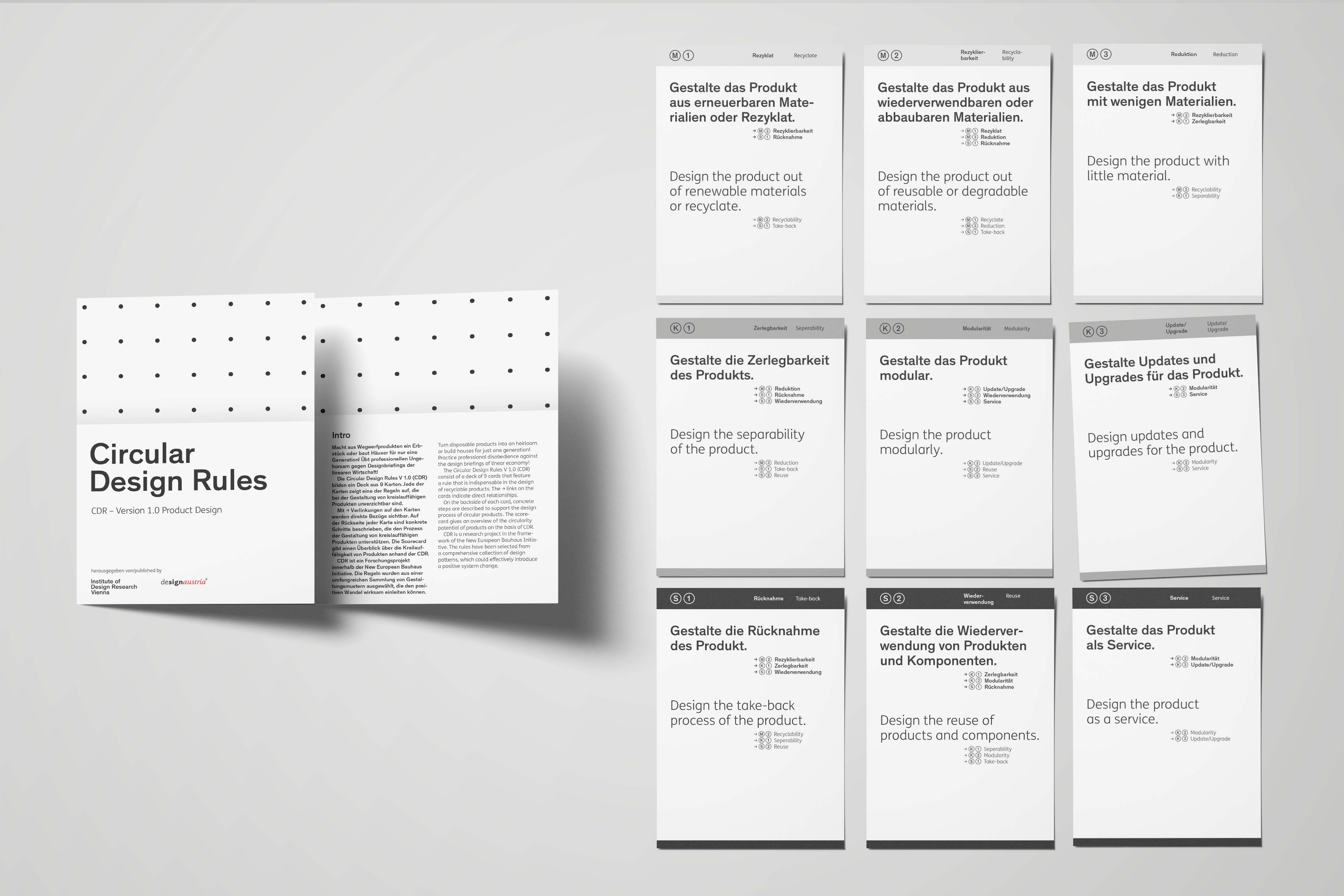

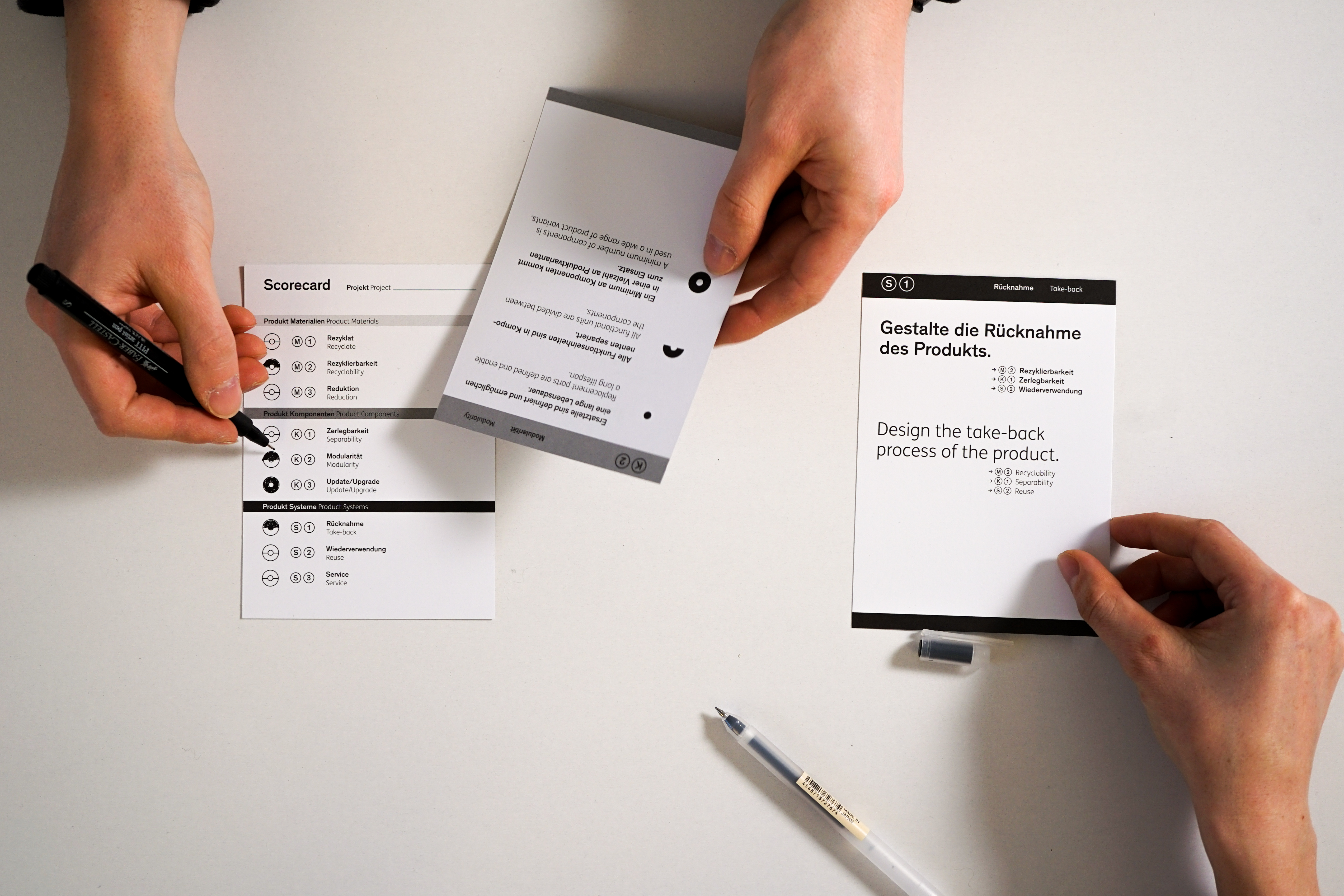
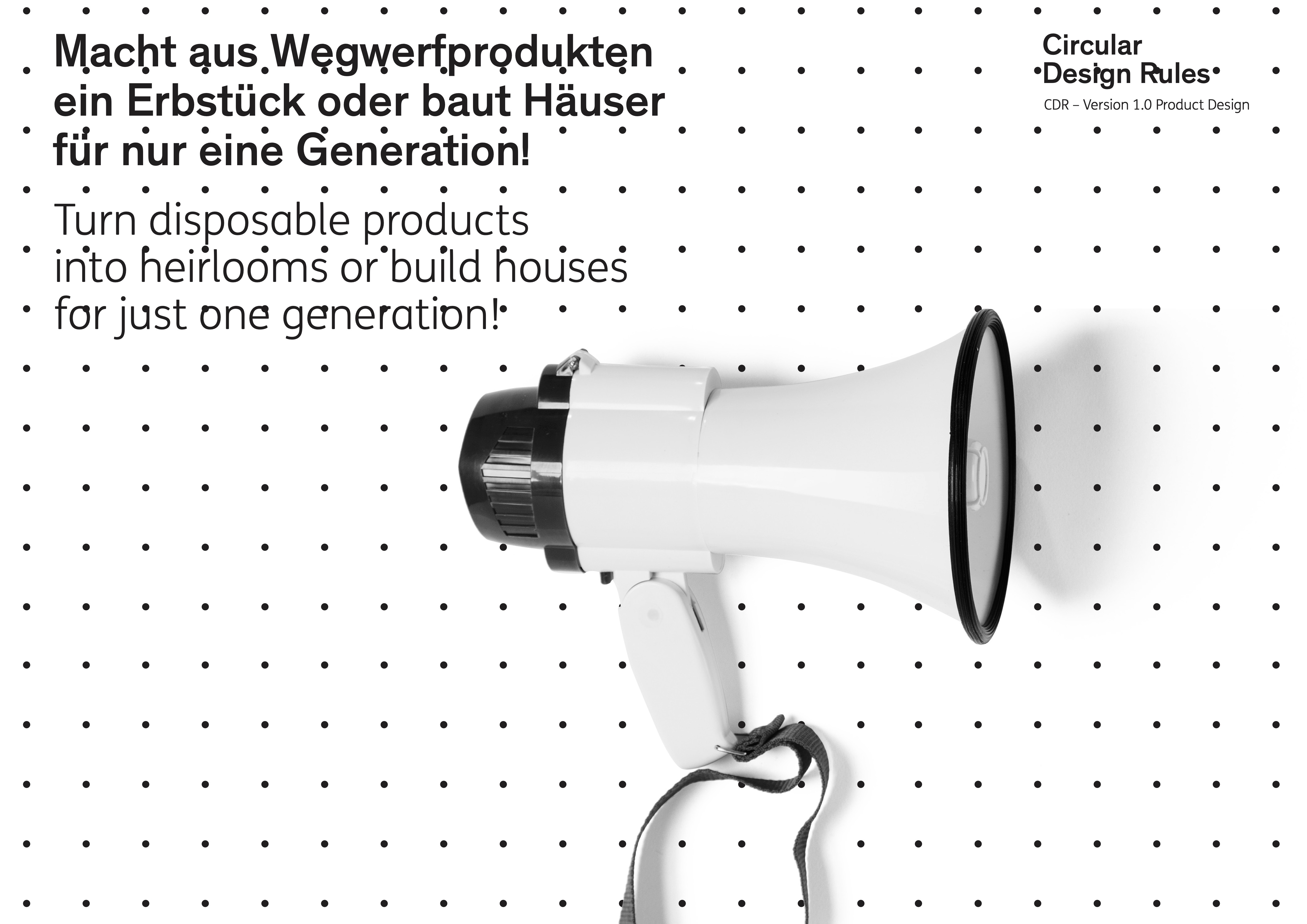
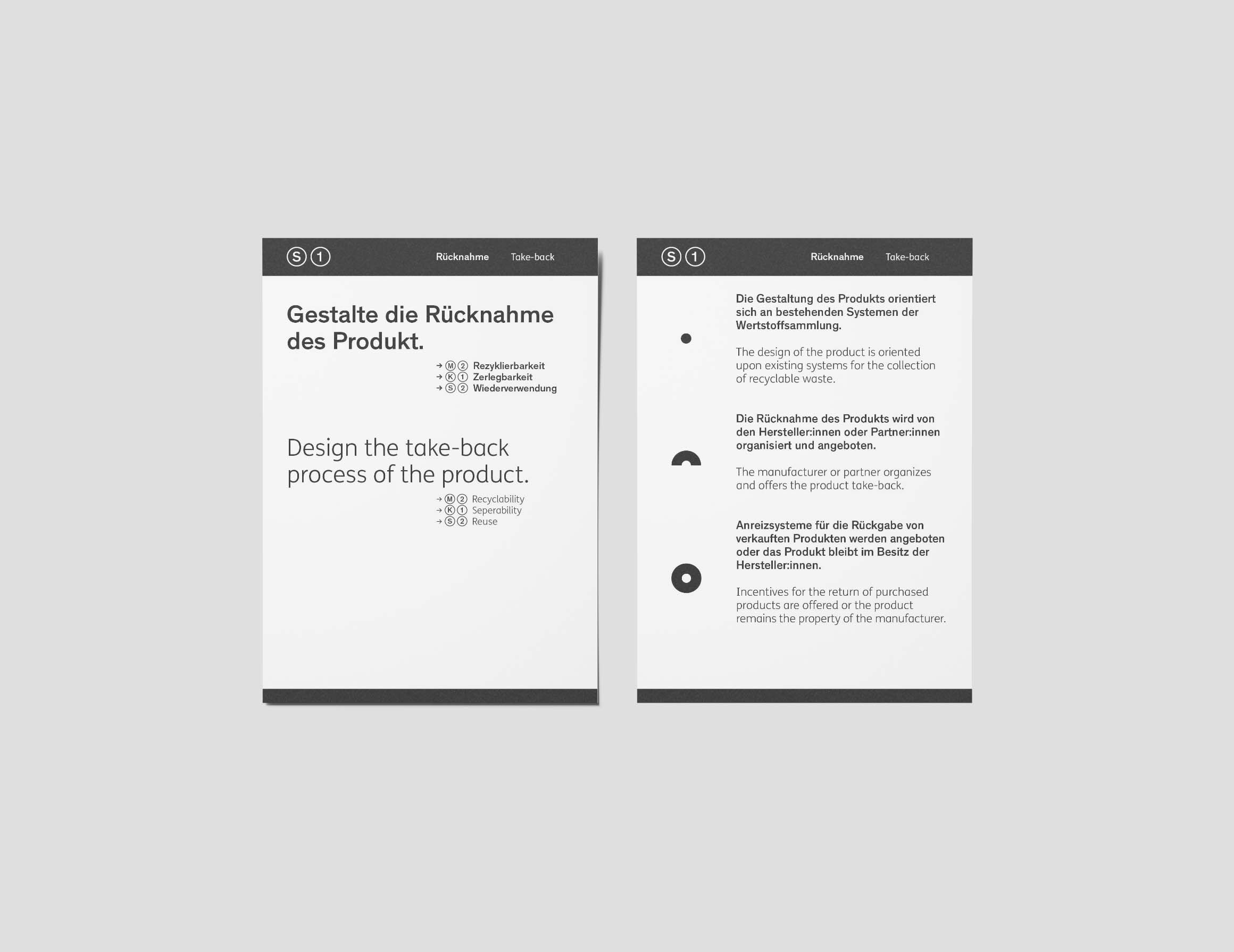
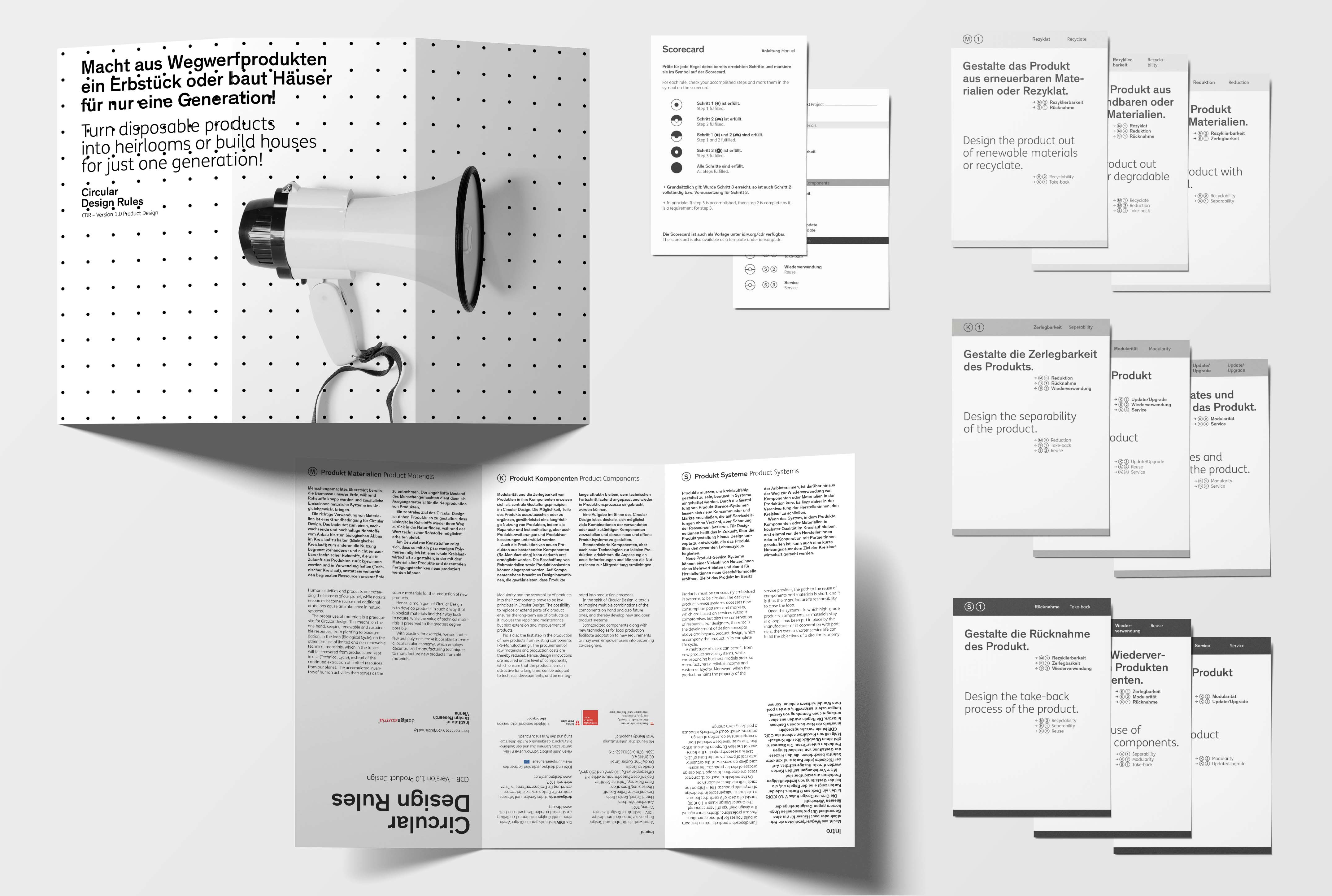
@Institute of Design Research Vienna, 2021
Content licensed to the European Union.